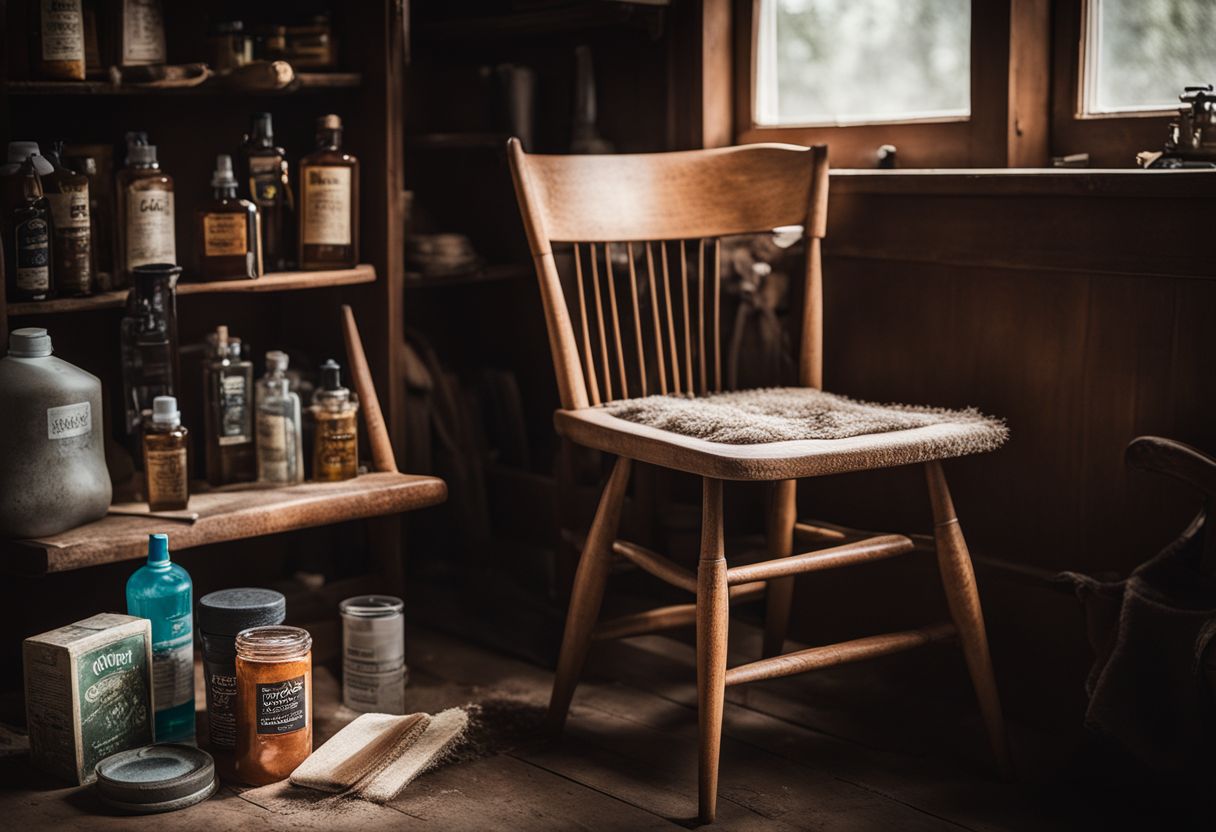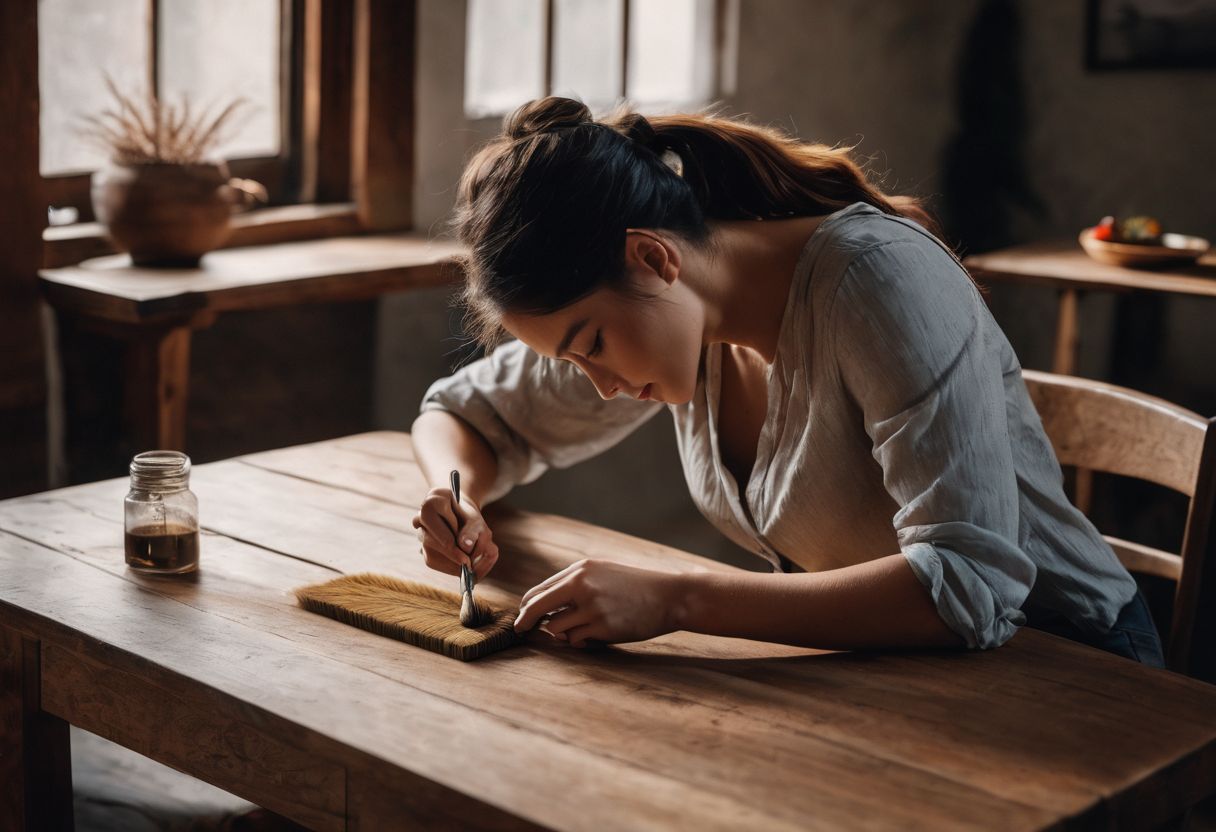Revitalize Your Treasures: How to Clean and Restore Wood Furniture Like a Pro
Ever found yourself sighing in disappointment at a beloved piece of wood furniture that’s lost its luster? I share your pain. We all have those precious wooden pieces that, over time, lose their fight against dust and scratches.
Just when it feels like there’s no hope left for them, let me assure you – there is! After countless trials and endless research hours, I’ve uncovered methods that can help breathe new life into your worn-out wood furniture.
In this guide, we’ll walk through every step together on how to clean and restore wood furniture– breaking down the power of elbow grease mixed with some simple household items to transform those tired fixtures back into polished masterpieces – ready to start our restoration journey?.
Key Takeaways
- Dust wood furniture using a feather duster or soft cloth to remove dust, avoiding abrasive materials that can damage the surface.
- Clean wood furniture with a mild cleaning solution made of water and dish soap, or try oil soap for older and dirtier pieces.
- Apply wax or polish to protect and enhance the shine of wood furniture, making sure to choose the right product for your specific needs.
- Regularly maintain wood furniture by dusting with a feather duster or damp cloth, avoiding excessive moisture and using gentle strokes.
How to Clean and Restore Wood Furniture: What You Will Need

To clean and restore wood furniture, you will need dusting tools, a cleaning solution, and wax or polish.
Dusting tools
I always start with dusting tools to clean my wood furniture. A feather duster is a good choice. The dust clings to it well so it cleans in one go. Other tools can work too, as long as the dust sticks to them.
This makes sure no dust is left behind on the furniture. Always choose a tool that catches and holds onto the dust for effective cleaning.
Cleaning solution
I have a few great tips for making a cleaning solution. First, I use a mix of water and dishwashing soap. This is not too strong but cleans very well. If the wood furniture is really dirty, I bump it up with mineral spirits.
For old wood furniture in need of some love, oil soap combined with water works wonders. It takes off grime that hides the beauty of the piece. White vinegar and olive oil also make a good cleaner for this type of job.
If you want to clean and put moisture back into old dry wood at the same time, try using hemp oil mixed with distilled white vinegar. It’s like giving your wood furniture a full spa day!
Lastly, no matter what solution I choose to use, my trusty lint-free cloth is always by my side ready to polish my wooden treasures every week.
Wax or polish
Choosing between wax or polish for your wood furniture is not easy. Both have good points. Wax gives a solid finish and shines very well. Polish also makes the furniture shine, but puts on a thin coat.
But, there’s one big rule to follow: don’t put polish on waxed furniture! The polish can take off the wax. Use clean cloth when putting on antique furniture wax. Stick with clear paste furniture wax if your piece has a wax-based finish already.
If you want to make your own mix, try beeswax and oil for an all-natural choice!
How to Dust Wood Furniture

To dust wood furniture, start by choosing the right tool, such as a microfiber cloth or a soft-bristle brush.
Choosing the right tool
When it comes to dusting wood furniture, choosing the right tool is crucial. One of the best options for dusting wooden surfaces is a feather duster, as it effectively traps and removes dust without scratching the furniture’s surface.
Other suitable tools include microfiber cloths or soft lint-free cloths that won’t leave behind any residue. Avoid using abrasive materials like harsh brushes or rough sponges, as they can damage the wood’s finish.
By selecting the appropriate tool for dusting, you can ensure that your wood furniture stays clean and well-maintained.
Proper dusting technique
To properly dust wood furniture, it’s important to use the right tool. Dust is abrasive and can scratch the surface, so gentle removal is key. You can use a soft cloth or a microfiber duster to gently wipe away the dust.
Make sure to go in one direction instead of back and forth, as this helps prevent streaks and swirls on the wood surface. Avoid using rough materials like paper towels or scrub brushes, as they can cause damage.
Remember, when you’re dusting wood furniture, be careful not to press too hard or use excessive force – a light touch will do the job!
How to Clean Wood Furniture
To clean wood furniture, gather the necessary tools such as a microfiber cloth, dish soap, and water. Mix the dish soap with warm water to create a cleaning solution. Use the dampened microfiber cloth to gently wipe down the surfaces of the furniture, removing dust and grime.
Be sure to avoid using excessive moisture that can damage the wood.
Preparing the cleaning solution
To prepare the cleaning solution for wood furniture, I like to start with a gentle option and then increase the strength if needed. One option is to mix a weak solution of warm water and dishwashing soap.
Another option is to pour Murphy’s oil soap into warm water. Distilled vinegar can also be used as a mild cleaner for most wood furniture. These solutions can help remove dirt and grime without damaging the wood surface.
Remember to always test the cleaner on a small, inconspicuous area before applying it to the entire piece of furniture.
Applying and buffing
To apply and buff wood furniture, I recommend using a mixture of equal parts olive oil, denatured alcohol, gum turpentine, and strained lemon juice. This can be applied onto the furniture using a soft cotton cloth in a buffing motion to revive its shine.
Make sure to cover all parts of the furniture, including the legs and arms. After applying the mixture, use another clean cotton cloth to buff the surfaces until they are smooth and shiny.
Don’t forget to regularly dust your wood furniture before applying this treatment for best results!
Removing sticky spots
To remove sticky spots from wood furniture, start by using a soft cloth to get rid of any loose debris. Gently wipe the affected area with a dry cloth. If there are stickers or glue remnants, you can use a plastic scraper to scrape them off without damaging the wood.
For stubborn residue and worn-out varnish, mix equal parts vinegar and water to create an acidic solution. Apply this mixture to the sticky spots and gently scrub with a soft cloth.
This should help lift away the stickiness and restore the beauty of your wood furniture.
How to Apply Furniture Wax
To restore the natural beauty of your wood furniture, learn how to properly apply furniture wax and bring out its shine.
Preparing the wax
To prepare the wax for your wood furniture, you have a few options. You can either use natural beeswax or a polish that contains vegetable wax. These types of waxes are great for protecting and enhancing the look of your furniture.
Before applying the wax, make sure that your wood surface is clean and dry. If there are any scratches or imperfections, you may want to sand them down gently before starting. Once your furniture is prepped, you can begin preparing the wax by following the instructions on the product label.
This may involve melting it slightly or stirring it until it becomes soft and pliable. Remember to choose a wax that matches the color of your wood to achieve a seamless finish.
Proper waxing and wiping technique
When applying furniture wax to wood furniture, it is essential to follow the proper technique to achieve a beautiful and shiny finish. Start by using a clean cloth to remove any excess wax from the surface.
Then, take a buffing cloth and work the wax into an even sheen on the furniture. To create a glossy finish, use circular motions while buffing with a clean, wax-free cloth. Remember not to apply furniture polish over the wax when cleaning; instead, use a feather duster or damp rag for regular maintenance.
In case you are dealing with antique furniture, opt for a soft cotton or lint-free cloth when applying wax. By following these simple steps, you can ensure that your wood furniture receives proper care and maintains its beauty for years to come.
Polishing and buffing
To achieve a polished and shiny finish on your wood furniture, you will need to polish and buff it properly. Start by applying a thin layer of furniture wax in the direction of the wood grain.
Let it sit for at least 24 hours to allow the wax to dry completely. Then, take a clean cloth and start buffing the surface in circular motions. This will help distribute the wax evenly and create a smooth, glossy shine.
Remember to remove any excess wax before buffing by wiping it away with a clean cloth. It’s important to buff in the direction of the wood grain for best results. This helps bring out the natural beauty of the wood while avoiding streaks or scratches.
Maintaining the finish
To maintain the finish of furniture wax, it’s important to regularly clean it with a feather duster or a damp rag. Instead of applying furniture polish over the wax, simply remove any dust or smudges using gentle strokes.
This will help preserve the natural shine and protect the wood from unnecessary buildup. After applying wax to your furniture, use a clean cloth to buff the waxed surface in circular motions for that beautiful shine.
Remember to go with the grain of the wood and avoid pressing too hard. By maintaining your furniture’s finish properly, you can ensure its longevity and keep it looking gorgeous for years to come.
How to Clean Old Wood Furniture
To clean old wood furniture, start by dusting the surface with a microfiber cloth to remove any loose dirt or debris. Then, mix a small amount of dish soap with warm water to create a cleaning solution.
Dip a clean cloth into the solution and gently scrub the furniture in circular motions. Be sure to avoid saturating the wood and wipe away any excess moisture immediately. For sticky spots, use a mild household cleaner specifically designed for wood surfaces.
Once cleaned, allow the furniture to dry completely before applying any wax or polish for added protection and shine.
Annual cleaning tips
To keep your old wood furniture looking its best, it’s important to give it an annual cleaning. Here are some simple tips to help you with this task. First, start by wiping the furniture with a damp microfiber cloth to remove any dust and dirt.
Then, mix oil soap according to the product label instructions and apply it to the furniture using a clean cotton cloth. Work the soap into the surface of the wood, being careful not to use too much water that can damage the furniture.
Finally, wipe off any excess soap and buff the wood with a dry cotton cloth until it shines. By following these steps once a year, you can keep your old wood furniture in great condition for years to come.
Restoring and restaining
Restoring and restaining wood furniture is an important step in bringing it back to its former glory. To begin, you can use a wood-cleaning soap mixed with water to remove any dirt or grime that may have accumulated over time.
Gently scrub the surface of the furniture using a soft cloth or sponge, being careful not to scratch the wood. After cleaning, you can then apply a coat of wood finish or stain to enhance its appearance and protect the wood from future damage.
It’s always best to follow the instructions on your chosen finish or stain product for optimal results. By restoring and restaining your old wooden furniture, you can give it new life while preserving its character and charm.
Remember, different types of wood may require specific restoration techniques and products, so it’s essential to do some research before starting your project. Additionally, if you’re unsure about how to restore or restain your furniture correctly, it’s always a good idea to seek advice from professionals who specialize in antique restoration or woodworking.
Monthly conditioning
To keep your old wood furniture in tip-top shape, it’s important to do monthly conditioning. This means applying a wax-based conditioner regularly to protect against drying and cracking.
By hydrating the wood and preventing it from becoming brittle, you can extend the lifespan of your furniture. Not only does this help preserve its natural beauty and shine, but it also shields the wood from environmental damage.
So don’t forget to give your wood furniture some TLC every month!
How to Clean Mold Off Wood Furniture
To effectively clean mold off wood furniture, use a vacuum to remove any loose spores and then clean with a mixture of dish soap and water. Rinse the furniture thoroughly, dry it completely, and protect it from further mold growth.
Click here to learn more about removing mold from wood furniture.
Vacuuming and cleaning
Vacuuming and cleaning are crucial steps in getting rid of mold from wood furniture. Mold spores can hide in the crevices and pores of the wood, so it’s important to thoroughly clean the surface.
Start by using a vacuum with a brush attachment to remove any loose dirt or debris from the furniture. After vacuuming, you can clean the affected area with a white vinegar solution or hydrogen peroxide spritz.
These solutions are effective at killing mold and preventing its growth. Remember to let the wood dry completely after cleaning, as moisture can promote mold growth.
Rinsing, drying, and protecting
After removing mold from wood furniture, it’s important to rinse off any cleaning solution or vinegar spray that was used. This can be done by lightly dampening a clean cloth and wiping down the surface.
Make sure to remove all traces of the cleaning solution to prevent any damage to the wood.
Next, allow the furniture to dry completely before applying any protective coating or wax. This will help ensure that moisture doesn’t get trapped underneath, which could lead to further mold growth or damage.
Once the furniture is dry, you can apply a protective coating or wax to restore its shine and protect it from future mold growth. Be sure to follow the instructions on your chosen product for best results.
How to Deep-Clean Wood Furniture
Remove stubborn grime and dirt from your wood furniture to reveal its natural beauty.
Removing grime and dirt
To thoroughly clean wood furniture and remove grime and dirt, start by dusting the surface to get rid of any loose particles. Use a microfiber cloth or a soft brush for this step. Then, prepare a cleaning solution by mixing modern soap with warm water.
Dip another microfiber cloth into the solution and wring it out so that it’s barely damp. Gently wipe down the furniture, making sure to focus on areas with heavier buildup. For older wooden furniture with layers of grime, you may want to use oil soap specifically designed for wood, like Murphy Oil Soap Wood.
After wiping down the furniture, go over it again with a clean, dry microfiber cloth to remove any excess moisture and ensure a streak-free finish.
Waxing the furniture
To deep-clean wood furniture, waxing is an important step. Before applying wax, make sure to wipe off any excess with a soft cotton cloth. Then, using a clean cloth or lint-free cloth, apply the wax in a thin and even layer.
Work the wax into the wood using circular motions until the entire piece of furniture is covered. Afterward, use a buffing cloth to create an even sheen on the surface. Regularly polishing and waxing your wood furniture will help maintain its shine and can also remove minor scratches or nicks that may have occurred over time.
How to Repair Surface Scratches on Wood Furniture
Learn how to easily treat surface scratches on wood furniture using wax and restore the beauty of your beloved pieces.
Treating surface scratches with wax
To treat surface scratches on your wood furniture, you can use wax. It’s a simple and effective method that helps restore the appearance of the furniture. Start by cleaning the area around the scratch to remove any dirt or debris.
Then, apply a small amount of wax directly onto the scratched area and gently rub it in with a soft cloth. Make sure to follow the grain of the wood as you work. Afterward, use another clean cloth to buff and polish the treated area until it shines.
This will help blend in the scratch and make it less noticeable. Remember, for deep scratches, you may need to remove the damaged finish completely before treating with wax. But for minor surface scratches, using wax is a quick and easy way to restore your wood furniture’s appearance without much hassle or expense.
Dealing with deep scratches
To deal with deep scratches on wood furniture, you can create a simple mixture using equal parts of cooking oil and white vinegar. Apply this mixture to the scratches using a rag and rub it onto the surface of the wood.
This will help to minimize the appearance of the scratches and make them less noticeable. For even deeper scratches, you can fill them with stain by dipping a rag or paint brush into the stain and spreading it along the inside of the scratch until it is filled.
Afterward, sanding the entire surface of the wood furniture with fine-grit sandpaper (around 220 grit) will help remove small scratches and prepare for repair. Once you’re done sanding, wipe away any residue with a clean cloth or paper towel to complete the process.
Wood Furniture Care Tips
Maintain the beauty of your wood furniture with these simple care tips. Read on to discover how to polish hardware, remove stubborn stains, and make your wood furniture look brand new again.
How to polish hardware
To polish hardware on wood furniture, start by cleaning the hardware to remove any dirt and sticky substances. You can use a solution of oil soap or mild dish soap mixed with warm water.
Test the cleaning solution on a small area before applying it to the entire hardware. Once you’ve cleaned the hardware, dry it thoroughly with a clean cloth.
Next, apply a thin layer of furniture wax to the hardware using a soft cloth or brush. Make sure to cover all areas evenly. After applying the wax, let it sit for a few minutes to penetrate into the surface.
Then, use a clean cloth to gently buff and polish the hardware in circular motions until it shines. Be careful not to apply too much pressure as this may cause damage.
Best dusting tools for wood furniture
When it comes to dusting wood furniture, using the right tools is important. One of the best options is a microfiber cloth. Microfiber cloths are soft and gentle, making them perfect for cleaning delicate wooden surfaces without causing any damage.
They also have small fibers that can capture and hold onto dust particles effectively. Another great tool to consider is a soft-bristled brush or feather duster, which can help you reach tight corners and crevices.
Avoid using rough materials like paper towels or abrasive brushes as they can scratch the surface of your furniture. Choose the best dusting tools for wood furniture to keep it looking clean and beautiful.
Removing old polish and water stains
To remove old polish and water stains from wood furniture, there are a few simple steps you can follow. First, aim a hairdryer at the stain and hold it until the stain disappears. This method helps to lift the moisture out of the wood’s surface.
Once the stain is gone, you can use furniture oil to polish the table and restore its shine. The oil will help protect the wood and bring back its natural luster. Remember to always test any cleaning solution or oil on a small, inconspicuous area before applying it to your entire piece of furniture.
Erasing difficult marks
When it comes to erasing difficult marks from wood furniture, there are a few things you can try. One option is to use an oil soap and water solution. This can help loosen up tough stains and stubborn marks.
Another approach is to start with basic cleaning, which may help remove dirt and sticky substances that could be causing the difficult marks. However, there are no specific techniques or products mentioned for directly erasing difficult marks on wood furniture in the article, so it’s important to proceed with caution and test any cleaning solutions on a small inconspicuous area first.
Using homemade furniture polish.
To clean and restore wood furniture, you can make your own homemade furniture polish. One simple recipe is a mixture of white vinegar and olive oil. The vinegar helps to clean the wood while the oil moisturizes it.
Just combine equal parts vinegar and oil in a spray bottle, give it a good shake, and then spray it onto a microfiber cloth. Gently rub the cloth over the surface of your wooden furniture to remove dirt and grime.
Another option is to mix hemp oil with distilled white vinegar in a ratio of 3 parts oil to 1 part vinegar for an effective homemade cleaner and polish for your wood furniture. Using these homemade solutions can help keep your wooden furniture looking clean and shiny without any harsh chemicals or additives.
Conclusion
In conclusion, cleaning and restoring wood furniture can be a straightforward process with the right tools and techniques. By following the step-by-step guide provided in this article, you can remove grime, restore shine, and preserve the beauty of your wooden furniture.
Whether you’re dealing with antique pieces or simply want to refresh your everyday furniture, these tips will help you achieve impressive results. Don’t let dirt and wear dull the natural beauty of your wood furniture – take action today to bring back its original splendor!
FAQs
1. What supplies do I need to clean and restore wood furniture?
To clean and restore wood furniture, you will need a soft cloth, mild soap or wood cleaner, water, fine steel wool or sandpaper for refinishing, and wood polish or wax for finishing.
2. Can I use regular household cleaners on wood furniture?
No, it is not recommended to use regular household cleaners as they can be too harsh and damage the wood. Use a mild soap or specifically formulated wood cleaner instead.
3. How do I remove scratches from wood furniture?
To remove scratches from wood furniture, gently rub them with fine steel wool or sandpaper in the direction of the grain until smooth. Then apply a matching color touch-up marker or stain if needed.
4. How often should I clean and restore my wood furniture?
Regular cleaning should be done at least once every few months to remove dust and dirt buildup. Restoration such as refinishing can be done as needed when the finish starts to wear off or there are noticeable damages.
5. Are there any precautions I need to take when cleaning and restoring wood furniture?
Yes, when cleaning and restoring wood furniture, avoid using excessive water that can cause warping or swelling of the wood. Always test any new products on a small inconspicuous area first before applying them to the entire piece of furniture







